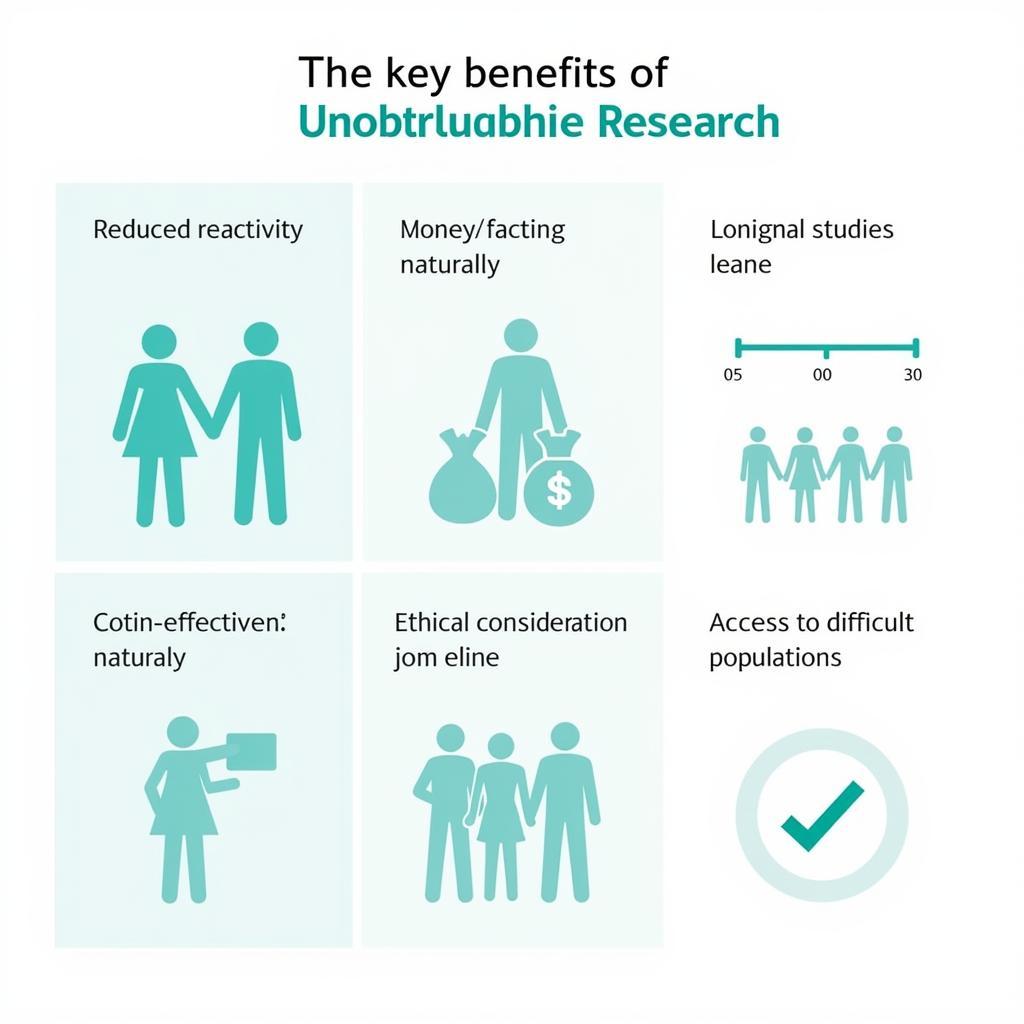Unobtrusive research is a research method where the researcher does not directly interact with the subjects being studied. This approach minimizes the impact of the researcher’s presence on the natural behavior and environment of the participants, allowing for a more authentic and unbiased data collection process. It’s a powerful tool for understanding social phenomena without influencing the results. But what exactly does it entail, and why is it so valuable?
Unveiling the Essence of Unobtrusive Research
Unobtrusive research often involves analyzing existing data sources, such as historical records, public documents, or media content. It can also include observing behavior in natural settings without the subjects’ knowledge, like analyzing online discussions or studying patterns in urban environments. This method allows researchers to examine social interactions and trends in a way that traditional, interactive research methods often can’t.
Different Types of Unobtrusive Research
Unobtrusive research encompasses a range of methods, each with its own strengths and applications:
- Content Analysis: This involves systematically analyzing textual or visual content to identify patterns, themes, and meanings. Think of analyzing newspaper articles to track public opinion on a specific issue.
- Physical Trace Analysis: This method examines the physical evidence left behind by human activity. For example, studying the wear and tear on library books to determine their popularity.
- Archival Research: This involves using existing records, documents, and artifacts to understand past events and social phenomena. Imagine researching historical census data to understand demographic shifts.
- Existing Statistics Analysis: This method utilizes previously collected statistical data, such as government reports or survey data, to answer research questions. A researcher might analyze crime statistics to understand trends in criminal activity.
- Observation: This involves observing behavior in natural settings without interacting with the subjects. For instance, a researcher might observe pedestrian traffic flow to understand urban mobility patterns.
Advantages of Using Unobtrusive Research
Why choose unobtrusive research over other methods? Several key advantages make it a compelling option:
- Minimizes Reactivity: Because subjects are unaware of being observed, their behavior is less likely to be influenced by the researcher’s presence, leading to more authentic data.
- Cost-Effective: Often utilizes existing data sources, reducing the need for expensive data collection procedures.
- Longitudinal Studies: Archival data allows researchers to study trends and changes over extended periods.
- Ethical Considerations: Reduces ethical concerns associated with direct interaction and manipulation of subjects.
- Access to Difficult Populations: Can be used to study groups that are hard to reach or unwilling to participate in traditional research.
 Benefits of Unobtrusive Research
Benefits of Unobtrusive Research
When is Unobtrusive Research the Right Choice?
Unobtrusive research is particularly useful when studying sensitive topics, historical trends, or behaviors that are difficult to observe directly. It’s a valuable tool for exploring complex social phenomena in a natural and unobtrusive manner.
Examples of Unobtrusive Research in Action
Let’s explore some real-world examples of how unobtrusive research has been applied:
- Analyzing social media posts to understand public sentiment towards a new product.
- Studying graffiti art to gain insights into subcultures and social commentary.
- Examining historical records to understand the impact of a specific policy change.
- Using Google Trends data to analyze the popularity of different search terms over time.
Imagine a researcher studying the impact of a public health campaign. Instead of conducting surveys or interviews, they might analyze social media posts to gauge public awareness and attitudes towards the campaign. This unobtrusive approach provides a valuable window into the campaign’s effectiveness without directly influencing public opinion.
“Unobtrusive research offers a unique lens into human behavior, allowing us to capture the nuances of social interaction without disrupting the natural flow of events,” says Dr. Amelia Carter, a leading sociologist at the University of California, Berkeley. “It’s a powerful tool for understanding the complexities of the human experience.”
Define Unobtrusive Research: A Conclusion
Unobtrusive research provides a valuable methodology for exploring a wide range of social phenomena. By minimizing researcher influence and utilizing existing data sources, this approach offers a unique perspective on human behavior and social interaction. Understanding the nuances of unobtrusive research can empower researchers to unlock deeper insights and contribute to a more comprehensive understanding of the world around us.
 Unobtrusive Research Conclusion
Unobtrusive Research Conclusion
FAQ
- What is the main advantage of unobtrusive research? Minimizing researcher influence on participants’ behavior.
- What are some examples of unobtrusive research methods? Content analysis, physical trace analysis, and archival research.
- When is unobtrusive research most useful? When studying sensitive topics or hard-to-reach populations.
- How does unobtrusive research differ from traditional research methods? It avoids direct interaction with research subjects.
- What are some ethical considerations related to unobtrusive research? Privacy concerns and ensuring anonymity of subjects.
- Can unobtrusive research be used in conjunction with other research methods? Yes, it can complement other approaches for a more holistic understanding.
- Where can I find resources to learn more about unobtrusive research? Academic libraries, research journals, and online databases.
Need support? Contact us 24/7: Phone: 0904826292, Email: research@gmail.com or visit us at No. 31, Alley 142/7, P. Phú Viên, Bồ Đề, Long Biên, Hà Nội, Việt Nam.